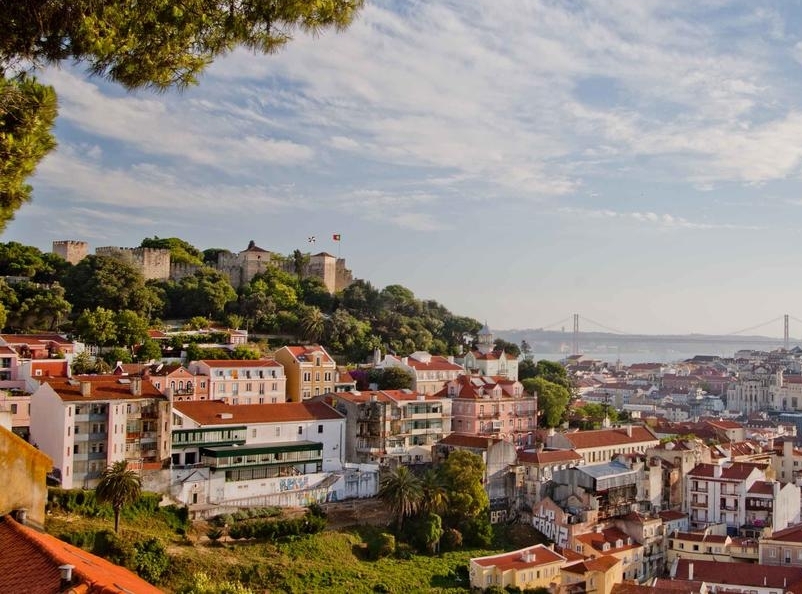

Graça dates back to the foundation of an Agostinhos Convent ,a thirteenth century construction under the name of St. Augustine. In 1305, this convent became Convento da Nossa Senhora da Graça, after which the neighbourghood was then named.
A long time ago, Graça was located outside the walls of Lisbon (out of the Moorish walls) and only with the construction of Fernandina wall in 1371 did it become part of the city. There can still be seen remains of the towers of the walls inside the convent.
The neighbourhood, which back then was little more than farming land, remained very sparsely inhabited for centuries. From the sixteenth century on, there began to emerge several palaces such as Vila Sousa, António Ribeiro Barros', the Figueira Palace and the Lords of Trofa's. It was due to this increase in population that the Graça Theatre is founded in 1767. This theatre soon stood out in the artistic panorama of the city.
The eighteenth century already saw several religious buildings punctuating the landscape which had become more densely populated. The big turning point in the Graça neighbourhood history only occurred after the earthquake of 1755, though. The reconstruction of the city led an increasingly large number of workers to seek Graça to reside in. Not only was the land cheap, but the neighbourhood was also close to downtown.
In the early nineteenth century, the first streets were already established and the neighbourhood was structured beyond the Largo da Graça. The neighbourhood saw the pavement emerging and connecting the neighborhood to the São Jorge Castle and the street that linked off of Sappers.
It was only in the early twentieth century that the neighborhood definitely lost its rural aspect, with the construction of the Santa Apolónia railway.
This revolutionized the industrial life of the neighborhood, which suddenly saw the emergence of multiple ateliers, and attracted many working class and white-collar workers. This dynamism led to several associations such as the Savings Bank Workers and Desportivo da Graça Club.
Today Graça is this charming neighborhood we know: a mixture of old and new, where the spirit of old Lisbon is felt and the renewal brought about by the new inhabitants.

Next to the Graça Church, there are almost two hectares of green spaces with a long central lawn, with 180 trees and bushes and also a picnic area with a fruit orchard. People who walk in this garden can hardly believe that it wasn't open to the public until very recently, in 2015.
From Jardim da Cerca da Graça you can admire the fabulous view over old Lisbon which spreads from the Castle of St. George to the Moorish quarter as it takes advantage of the sun's rays or even a cool shade on a hot day. The ancient land of the Ministry of Defense gave Lisbon new lungs, being ideal for the inhabitants of the Graça neighborhood.
In 1995, José Sá Fernandes, Councilman of the Green Structure of the City of Lisbon (Estrutura Verde da Câmara Municipal de Lisboa), at the time without any link to the local authority, wrote a letter for the City Hall to order the construction of a garden on these same grounds, at the time belonging to the Convent da Graça.
Twenty years later, the garden managed to finally open its doors. And they burst open, not only for the Graça neighbourhood residents but for weekenders and tourists.Today you can enjoy the panoramic view over the Castle and the Tagus river, enjoy the garden, the playground or the kiosk where many people flock to at sunset.
Having a green area of this size in the heart of a European capital is a genuine luxury. In addition to this, this space also enabled to shorten the distance between downtown and Graça.

Because Graça is located on the highest hill of Lisbon, this is where the best viewpoints are. In fact, it has not one, but two viewpoints: the viewpoint of Graça and the viewpoint of Senhora do Monte that despite being packed with weekenders and tourists every day, always allow an unobstructed view over the capital. This feature accounts for the fact that Graça is one of Lisbon's top 5 secrets places to visit.
Senhora do Monte
This viewpoint is in front of the chapel of the same name, and it has been one of the best-kept secrets in Lisbon. It has the best view over the city and it is located at the very top of the Graça neighbourhood. The panoramic view covers the Tagus estuary, the Castle of São Jorge, downtown, Bairro Alto, Serra de Monsanto and Avenida Almirante Reis.
To get there it's a bit of a climb. We recommend that you take the Rua da Graça from Graça square, and then turn towards the viewpoint. All this effort will then be rewarded with the sight from one of the highest points of the city. In the tile panel next to the chapel there can be identified the various monuments that are observed from the viewpoint.
Miradouro da Graça
The Graça viewpoint , formally known as Sophia de Mello Breyner Andresen viewpoint, is located in the square of the same name. The panoramic view from this viewpoint allows you to see from the Castle of São Jorge up to the river, the Mouraria, downtown, the colorful houses of Lisbon, and its the streets and gardens.
Here, in addition to the landscape, you can also enjoy the tranquility of the terrace served by a bar.



